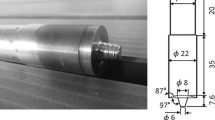Abstract
The effect of peening on the fatigue crack growth performance of friction stir-welded 7075 aluminum alloy was investigated. The fatigue crack growth rates were assessed for laser- and shot-peening conditions at stress ratios (R) of 0.1 and 0.7. The surface and through thickness residual stress distributions were characterized for the different regions in the weld. The results indicate a significant reduction in fatigue crack growth rates using laser peening compared to shot peening and the as-welded condition. The effect of the compressive stresses obtained through laser peening was deemed responsible for increasing the resistance to fatigue crack growth of the welds.















Similar content being viewed by others
References
Pao P., Gill, S. Feng C., Sankaran, K. Corrosion-Fatigue Crack Growth in Friction Stir Welded Al 7075. Scripta Materialia 45 (2001) 605-612
Rhodes C., Mahoney M, Bingel W, Spurling R, Bampton W. Effects of Friction Stir Welding on Microstructure of 7075 Aluminum. Scripta Materialia 1997, Vol. 36, No. 1, pp 69-75.
W.M. Thomas, E.D. Nicholas, J.C. Needham, M.G. Murch, P. Templesmith, and C.J. Dawes, Friction Stir Butt Welding, Int Patent App PCT/GB92/02203, and GB Patent App 9125978.8, 297 US patent No. 5,460,317, October 1995
Staron, P.; Kocak, M.; Williams, S.; Wescott, A.. Residual stress in friction stir-welded A1 sheets. Physica B: Condensed Matter, v 350, n 1-3 SUPPL. 1, Jul 15, 2004, p e491-e493
Ericsson M, Sandstrom R. Influence of Welding Speed on the Fatigue of Friction Stir Welds, and Comparison with MIG and TIG. International Journal of Fatigue 25 (2003) pp 1379-1387.
Bussu G. Irving P.E. The role of residual stress and heat affected zone properties on fatigue crack propagation in friction stir welded 2024- T351 aluminum joints. Int J Fatigue; 2003. 25:77–88
Hatamleh O, Lyons J, and Forman R. Laser and Shot Peening Effects on Fatigue Crack Growth in Friction Stir Welded 7075-T7351 Aluminum Alloy Joints. International Journal of Fatigue. Volume 29, Issue 3, March 2007, Pages 421-434.
John, R et al. Residual stress effects on near-threshold fatigue crack growth in friction stir welds in aerospace alloys. Int J Fatigue 2003;25:939–48.
Mahoney MW et al. Properties of friction-stir-welded7075 T651 aluminum. Metall Mater Trans A 1998;29:1955–64.
J. Tyson, T. Schmidt, and K. Galanulis, Advanced Photogrammetry for Robust Deformation and Strain Measurement, Proceedings of SEM 2002 Annual Conference (Milwaukee, WI), June 2002
Schmidt, T., Tyson, J., Galanulis, K., Full-Field Dynamic Displacement and Strain Measurement Using Advanced 3D Image Correlation Photogrammetry, Experimental Techniques, Vol.27, No.3, pp.41-44, May/June 2003.
W. D. Lockwood, Borislav Tomas, and A. P. Reynolds “Mechanical Response of Friction Stir Welded AA 2024: Experiment and Modeling”,, Materials Science and Engineering, A, January 2002, vol. 323/1-2, pp. 349-354.
W. D. Lockwood and A. P. Reynolds “Simulation of the Global Response of a Friction Stir Weld Using Local Constitutive Behavior”, Materials Science and Engineering, A, January 2003, vol 339/1-2 pp 35-42.
M. Prime and A.R. Gonzales, The Contour Method: Simple 2-D Mapping of Residual Stresses, Proceedings of the 6th International Conference on Residual Stresses, Vol. 1 (Oxford, UK), July 10–12, 2000, p 617–624
Prime, M., Cross-Sectional Mapping of Residual Stresses by Measuring the Surface Contour After a Cut, Journal of Engineering Materials and Technology, Vol 123, pp. 162-168, 2001
Peel M et al. Microstructure, mechanical properties and residual stresses as a function of welding speed in aluminum AA5083 friction stir welds. Acta Mater 2003;51:4791–801.
Svenson L, Karlsson L, Larsson H, Karlsson B, Fazzini M, Karlsson J. Sci. Tech. Weld. 2000; 5(5) pp 285-296.
Goloborodko, A. et al. Friction stir welding of a commercial 7075-T6 aluminum alloy: grain refinement, thermal stability and tensile properties. Materials Transactions, Vol. 45, No. 8 (2004) pp. 2503 to 2508
Venugopal, T. et al. Studies on friction stir welded AA 7075 aluminum alloy. Trans. Indian Inst. Met. Vol. 57, No. 6, 2004, pp. 659-663.
A.P. Reynolds, W. Tang, Z. Khandkar, J. A. Khan, and K. Lindner. Relationships among weld parameters, hardness distributions, and temperature histories in alloy 7050 friction stir welds”, Science and Technology of Welding and Joining, vol. 10, no. 2, 2005, pp. 190-199.
C. Dale Donne, E. Lima, J. Wegener, A. Pyzalla, and T. Buslaps, Investigations on Residual Stresses in Friction Stir Welds, 3rd International Symposium on Friction Stir Welding (Kobe, Japan), 2001
O. Hatamleh, Surface Hardness Changes in Laser Peened Friction Stir Welded 2195 and 7075 Aluminum Alloys, Int. J. Surf. Sci. Eng., 2008, 2(1/2)
G. Pouget, A.P. Reynolds. Residual stress and microstructure effects on fatigue crack growth in AA2050 friction stir welds International Journal of Fatigue 30 (2008) 463–472.
Author information
Authors and Affiliations
Corresponding author
Rights and permissions
About this article
Cite this article
Hatamleh, O., Forth, S. & Reynolds, A.P. Fatigue Crack Growth of Peened Friction Stir-Welded 7075 Aluminum Alloy under Different Load Ratios. J. of Materi Eng and Perform 19, 99–106 (2010). https://doi.org/10.1007/s11665-009-9439-1
Received:
Revised:
Accepted:
Published:
Issue Date:
DOI: https://doi.org/10.1007/s11665-009-9439-1




